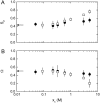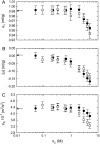Rigidification of neutral lipid bilayers in the presence of salts
- PMID: 17586572
- PMCID: PMC1989724
- DOI: 10.1529/biophysj.107.112615
Rigidification of neutral lipid bilayers in the presence of salts
Abstract
We studied the influence of sodium and calcium chloride on the global and local membrane properties of fluid palmitoyl-oleoyl phosphatidylcholine bilayers, applying synchrotron small-angle x-ray diffraction, spin-labeling electron paramagnetic resonance spectroscopy, and differential scanning calorimetry, as well as simultaneous density and acoustic measurements. The salt concentration was varied over a wide range from 0 to 5 M. We found that NaCl leads to a continuous swelling of the bilayers, whereas the behavior of the bilayer separation dW in the presence of CaCl2 is more complex, showing an initial large dW value, which decreased upon further addition of salt and finally increased again in the high concentration regime. This can be understood by a change of balance between electrostatic and van der Waals interactions. We were further able to show that both salts lead to a significant increase of order within the lipid bilayer, leading to a decrease of bilayer elasticity and shift of main phase transition temperature. This effect is more pronounced for Ca2+, and occurs mainly in the high salt-concentration regime. Thus, we were able to reconcile previous controversies between molecular dynamics simulations and x-ray diffraction experiments regarding the effect of salts on neutral lipid bilayers.
Figures







Similar articles
-
Molecular dynamics simulation of a palmitoyl-oleoyl phosphatidylserine bilayer with Na+ counterions and NaCl.Biophys J. 2004 Mar;86(3):1601-9. doi: 10.1016/S0006-3495(04)74227-7. Biophys J. 2004. PMID: 14990486 Free PMC article.
-
A DSC and FTIR spectroscopic study of the effects of the epimeric 4-cholesten-3-ols and 4-cholesten-3-one on the thermotropic phase behaviour and organization of dipalmitoylphosphatidylcholine bilayer membranes: comparison with their 5-cholesten analogues.Chem Phys Lipids. 2014 Jan;177:71-90. doi: 10.1016/j.chemphyslip.2013.11.008. Epub 2013 Dec 1. Chem Phys Lipids. 2014. PMID: 24296232
-
Anomalous swelling of lipid bilayer stacks is caused by softening of the bending modulus.Phys Rev E Stat Nonlin Soft Matter Phys. 2005 Apr;71(4 Pt 1):041904. doi: 10.1103/PhysRevE.71.041904. Epub 2005 Apr 7. Phys Rev E Stat Nonlin Soft Matter Phys. 2005. PMID: 15903698
-
Changes in phosphatidylcholine headgroup tilt and water order induced by monovalent salts: molecular dynamics simulations.Biophys J. 2004 Jun;86(6):3772-82. doi: 10.1529/biophysj.103.035816. Biophys J. 2004. PMID: 15189873 Free PMC article.
-
Effect of lipid peroxidation on the properties of lipid bilayers: a molecular dynamics study.Biophys J. 2007 Dec 15;93(12):4225-36. doi: 10.1529/biophysj.107.112565. Epub 2007 Aug 31. Biophys J. 2007. PMID: 17766354 Free PMC article.
Cited by
-
Cations Do Not Alter the Membrane Structure of POPC-A Lipid With an Intermediate Area.Front Mol Biosci. 2022 Jul 11;9:926591. doi: 10.3389/fmolb.2022.926591. eCollection 2022. Front Mol Biosci. 2022. PMID: 35898308 Free PMC article.
-
High- and low-affinity sites for sodium in δ-OR-Gi1α (Cys (351)-Ile (351)) fusion protein stably expressed in HEK293 cells; functional significance and correlation with biophysical state of plasma membrane.Naunyn Schmiedebergs Arch Pharmacol. 2014 May;387(5):487-502. doi: 10.1007/s00210-014-0962-8. Epub 2014 Mar 1. Naunyn Schmiedebergs Arch Pharmacol. 2014. PMID: 24577425
-
Room-temperature ionic liquids meet bio-membranes: the state-of-the-art.Biophys Rev. 2017 Aug;9(4):309-320. doi: 10.1007/s12551-017-0279-1. Epub 2017 Aug 4. Biophys Rev. 2017. PMID: 28779453 Free PMC article. Review.
-
Structure of POPC Lipid Bilayers in OPLS3e Force Field.J Chem Inf Model. 2022 Dec 26;62(24):6462-6474. doi: 10.1021/acs.jcim.2c00395. Epub 2022 Aug 31. J Chem Inf Model. 2022. PMID: 36044537 Free PMC article.
-
Molecular dynamics simulations of asymmetric NaCl and KCl solutions separated by phosphatidylcholine bilayers: potential drops and structural changes induced by strong Na+-lipid interactions and finite size effects.Biophys J. 2008 May 1;94(9):3565-76. doi: 10.1529/biophysj.107.116335. Epub 2008 Jan 25. Biophys J. 2008. PMID: 18222999 Free PMC article.
References
-
- Inoko, Y., T. Yamaguchi, K. Furuya, and T. Mitsui. 1975. Effects of cations on dipalmitoyl phosphatidylcholine/cholesterol/water systems. Biochim. Biophys. Acta. 413:24–32. - PubMed
-
- Lis, L. J., W. T. Lis, V. A. Parsegian, and R. P. Rand. 1981. Adsorption of divalent cations to a variety of phosphatidylcholine bilayers. Biochemistry. 20:1771–1777. - PubMed
-
- Lis, L. J., V. A. Parsegian, and R. P. Rand. 1981. Binding of divalent cations of dipalmitoylphosphatidylcholine bilayers and its effect on bilayer interaction. Biochemistry. 20:1761–1770. - PubMed
-
- Cunningham, B. A., and L. J. Lis. 1986. Thiocyanate and bromide ions influence the bilayer structural parameters of phosphatidylcholine bilayers. Biochim. Biophys. Acta. 861:237–242. - PubMed
-
- Cunningham, B. A., J. E. Shimotake, W. Tamura-Lis, T. Mastran, W. M. Kwok, J. W. Kauffman, and L. J. Lis. 1986. The influence of ion species on phosphatidylcholine bilayer structure and packing. Chem. Phys. Lipids. 39:135–143. - PubMed
Publication types
MeSH terms
Substances
LinkOut - more resources
Full Text Sources
Miscellaneous

